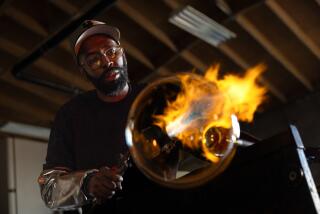DESIGN : Pottery That Plays With Fire : Artist Joan Rapoport says she delights in the <i> raku</i> technique because of the surprising textures and tones it creates in ceramics.
The artist in ceramics instructor Joan Rapoport will tell you she likes to make clay pots because it gives her a chance to ex press herself in three dimensions. âI like pottery because itâs a puzzle,â she said.
But thereâs a less intellectual side to the work. It lets her take part again in one of childhoodâs great endeavors: âmaking mud pies.â
For Rapoport, a ceramic firing technique known as raku lends itself well to the joys of playing with puzzles and pies. She delights in the precarious nature of the process and its unpredictable results.
âLook at those colors,â she said on a recent Friday, pointing to her raku pots and those of her firing partner, Dotty Patrick, which were cooling down at Everywomanâs Village in Van Nuys. âThe colors on the inside are always amazing. A lot more things happened in this pot than I envisioned--the color and the visual texture, the tones of copper.â
Rapoport teaches pottery and raku firing at the Village, and Patrick started taking classes with her about two years ago. âThereâs something about raku thatâs magical,â Patrick said. âYou never know how itâs going to turn out.â
The raku technique originated in 16th-Century Japan to make tea bowls for Zen Buddhist tea ceremonies. The word raku means pleasure, enjoyment, ease and was the name given to the son of the potter who made the first raku tea bowl.
The process was revived and altered in the United States in the 1960s. Today in this country, it refers to the visual results of placing a glazed pot, molten after having been heated in a kiln to more than 1,700 degrees, in a garbage can full of various combustible materials.
âThe pot is so hot, it sets the combustibles on fire instantly,â Rapoport said. âWe put the lid on the can and after the combustibles burn up, the process continues by feeding itself with available oxygen from the chemicals in the glazes.â
Pots are left to âsmokeâ for about 20 minutes. âThe smoke in combination with these chemicals produces the crackled and multicolored, metallic-looking glazed surfaces and smoked black unglazed surfaces we call raku, â Rapoport said. âThe two chemical compounds that produce the most color are copper carbonate and cobalt carbonate.â Copper red glazes, for instance, can produce a range of colors from red to blue, turquoise, purple, silver and pewter.
The serendipity of raku is enhanced by the quick, antic maneuvers a potter must make during the process. Students in Rapoportâs raku -firing workshops must be prepared to pull their pieces out of the kiln--with long-handled tongs or heavy gloves that can tolerate the 1,700-degree heat--and place them in the cans.
âThe pots are still so hot, they are the color of fire,â Rapoport said.
Since the combustibles in the cans begin to burn immediately, potters must slam the lids on their hot, smoking containers and scurry to place them in an open area where they can safely âsmoke.â The outcome of each potâs surface is left to the mysterious mix of the elements.
Many things can affect the final result: what a pot was next to in the kiln, weather conditions, or the content of combustibles. Rapoport has used everything from newspapers, leaves, sawdust, straw and hay to banana peels, oil-soaked rags and steer manure as a combustible--âanything that will burn,â she said.
Patrick and Rapoport, who âfeed off each otherâ when they fire together, Rapoport said, continually experiment with glazes and pot shapes. After using the same high copper matte glaze for seven years, Rapoport said, sheâs learned just âa little bit about it.â
The process seems to lend itself to whimsy, she said. And to Rapoport, this is its most exciting aspect. âI can play games with fish as wall hangings. I donât have to be practical,â she said. âItâs an outlet for my fun, and a neat way to turn people on to clay.â
(BEGIN TEXT OF INFOBOX / INFOGRAPHIC)
WHERE AND WHEN
What: Pottery and raku- firing classes. Location: Everywomanâs Village, 5650 Sepulveda Blvd., Van Nuys. Hours: Summer session begins July 17. Price: Raku, one all-day class, $47; seven three-hour ceramic classes, $123. Call: (818) 787-5100


